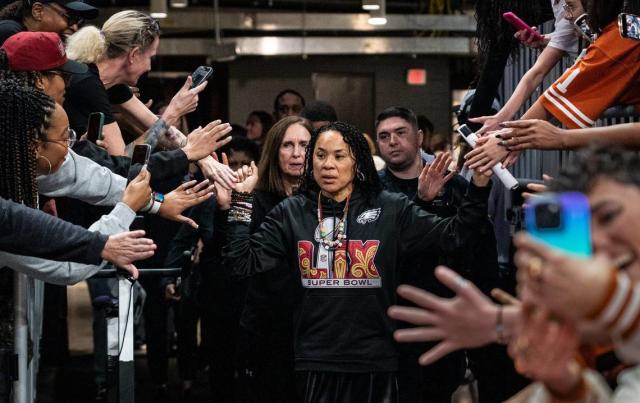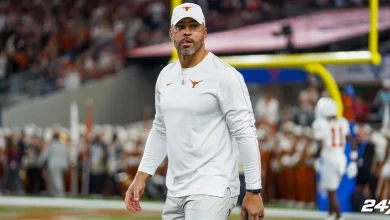Gamecocks in ‘Unfamiliar Territory’ in South Carolina, Says Dawn Staley

As the South Carolina Gamecocks continue to assert their dominance in women’s college basketball, it is no surprise that Dawn Staley has transformed the program into a perennial powerhouse. Under Staley’s leadership, the Gamecocks have captured multiple NCAA championships, consistently appeared at the top of the rankings, and developed a reputation for toughness, resilience, and excellence. However, even a program as successful as South Carolina is not immune to the shifting tides of college basketball, and this year, Staley’s Gamecocks find themselves in “unfamiliar territory” as they face new challenges and obstacles on their path to another successful season.
What makes this situation even more intriguing is that the “unfamiliar territory” Staley refers to isn’t necessarily about a lack of talent or ability—it’s about the evolving dynamics of the program, the changing landscape of women’s basketball, and the expectations that come with being one of the most dominant teams in the country. As South Carolina enters another season, the team finds itself navigating new challenges, both on and off the court, and facing a different kind of pressure that has come with their success.
Let’s delve deeper into what Staley meant by “unfamiliar territory,” and how the Gamecocks are responding to this new era of competition, uncertainty, and opportunity.
The Weight of Expectations: From Hunters to the Hunted
Historically, successful programs like South Carolina eventually face a shift in expectations. When Staley took over as head coach of the Gamecocks in 2008, she inherited a program that had seen some success but was far from a consistent contender on the national stage. Her focus was on building a team that could compete at the highest level, and she did so by recruiting top-tier talent, emphasizing defense, and instilling a culture of hard work and accountability. The result was a program that quickly ascended into elite status.
From 2017 to 2022, South Carolina established itself as the gold standard in women’s college basketball. The Gamecocks won their first NCAA title under Staley in 2017 and followed it up with another national championship in 2022. South Carolina became known for its unrelenting defense, aggressive rebounding, and ability to perform under pressure. Players like Aliyah Boston, Zia Cooke, and Bree Hall helped elevate the program into one of the most feared teams in the country, and Staley’s influence on the team and the sport as a whole grew exponentially.
However, with that success came a shift in the program’s role in the landscape of women’s college basketball. As South Carolina continued to win and achieve at the highest level, the Gamecocks found themselves in a new position: no longer the hunters but the hunted. This change is a critical part of the “unfamiliar territory” Staley referenced.
“For years, we’ve been the team everyone is chasing, but now we’re in a different spot,” Staley admitted. “The expectations are higher than ever, and the competition is stronger than it has been in a long time. We have to learn how to deal with that shift. We’re not just playing to win championships anymore—we’re playing to maintain the level we’ve set. And that’s a whole new kind of challenge.”
South Carolina’s dominance in women’s basketball has led to an increasing target on their backs. Every team they face brings its best effort, hoping to knock off the defending champions or at least prove themselves against the top-ranked team in the country. While Staley’s teams have thrived under pressure in the past, the weight of such expectations can be a difficult burden to bear. The Gamecocks now have to deal with not only their internal drive to stay at the top but also the external pressure of being the standard-bearers in a competitive landscape.
Roster Changes and the Transition of Leadership
One of the most significant changes for South Carolina this season is the shift in leadership. The departure of players like Aliyah Boston—a two-time NCAA champion and arguably the best player in the country during her time with the Gamecocks—has left a massive void. Boston’s leadership, presence in the paint, and rebounding ability were cornerstones of South Carolina’s success, and replacing her has proven to be no easy task.
Boston’s departure means that the Gamecocks need new players to step up into more prominent roles. While Bree Hall and Zia Cooke have been crucial contributors, the absence of a player like Boston leaves a gap in both the leadership structure and the overall on-court identity of the team. The transition from a team led by one of the best players in NCAA history to a more dynamic, balanced roster requires Staley and her staff to adapt their coaching and strategy to fit the new makeup of the team.
“It’s been a transition for us,” Staley said. “Aliyah was a player who could control the game in so many ways, and she was a natural leader. Now, we have a team full of talent, but we have to figure out how to make that talent come together. We’ve got players who are capable of leading, but it’s a different dynamic when you don’t have that one constant presence.”
Replacing Boston isn’t the only leadership challenge facing Staley’s team. While the Gamecocks have a wealth of talent, there has been some uncertainty about how the team will adjust to the leadership changes. The process of developing team chemistry, figuring out roles, and establishing a new hierarchy is a significant undertaking. And while South Carolina has a strong track record of doing just that under Staley’s guidance, it is still a learning process every time the roster changes.
Heightened Competition and the Rise of Other Programs
As South Carolina has ascended, other programs have risen to challenge them, which has made the competition fiercer than ever before. Teams like UConn, Stanford, Texas, and Louisville have all built competitive programs that are capable of challenging the Gamecocks on the national stage. These teams are not just looking to dethrone South Carolina—they are actively recruiting top talent, adjusting their coaching strategies, and positioning themselves to compete with the best.
One of the most significant shifts in women’s college basketball over the last few years has been the influx of talent to programs across the country. Texas, for example, has rapidly emerged as one of the top programs under head coach Vic Schaefer. With star players like Rori Harmon and a defensive-first philosophy, the Longhorns have positioned themselves as one of the biggest threats to South Carolina’s dominance.
The increase in competition means that the Gamecocks can no longer rely solely on their past successes or on individual players to carry the load. Every game is a challenge, and every opponent comes into each matchup with their own goals of beating the defending champions. For Staley, managing the expectations while also staying on top of the shifting dynamics of competition has been a delicate balance.
“Every year, there are new challengers, and that’s part of what makes this sport so exciting,” Staley said. “We have to adapt, evolve, and get better every single year. The level of competition keeps rising, and we’re not just focused on maintaining the standard. We’re focused on raising the bar.”
Building the Next Generation of South Carolina Talent
Another aspect of South Carolina’s “unfamiliar territory” is the emphasis on developing the next generation of talent. While Staley’s program is filled with experienced players, there’s also a significant amount of young talent waiting to step up. Freshmen and sophomores are now being asked to take on more responsibility, and their development is key to maintaining South Carolina’s competitive edge.
The transition from a team built around upperclassmen to one that incorporates younger players into leadership roles can be challenging. Staley is known for her ability to bring out the best in her players, and she is committed to ensuring that her younger players are prepared for the rigors of competition at the highest level.
“We have some very talented young players, but they have to learn what it takes to win at the highest level,” Staley said. “It’s about developing not just their basketball skills, but their mentality, their approach to the game. We’re going to need them to grow up fast, but that’s part of the process.”
South Carolina’s future is incredibly bright, but as Staley points out, that future depends on how quickly the younger players can adjust and make an impact on the court.
Navigating the Mental and Emotional Challenges of Success
While the physical and tactical challenges are clear, Staley also acknowledges the mental and emotional toll of sustained success. Being at the top year after year means managing a multitude of pressures, from maintaining focus and consistency to handling the mental strain that comes with being the team everyone is gunning for.
“The mental part of it is the hardest,” Staley said. “We’re at a point where people expect us to win. And while that’s a great position to be in, it can also be exhausting. The key is keeping our players grounded and focused on the right things.”
Staley’s ability to manage this emotional strain has been one of her greatest strengths. Her leadership extends beyond just tactical adjustments; it also includes helping her players navigate the complexities of being in the public eye, dealing with external pressures, and staying focused on the team’s goals.
A New Chapter for South Carolina
Dawn Staley’s acknowledgment of “unfamiliar territory” speaks volumes about the challenges South Carolina faces as it navigates its newfound role as the team everyone is aiming to beat. The transition from a team that is consistently at the top to one that must manage new expectations, new leadership dynamics
, and a highly competitive field is not an easy one. However, with Staley at the helm, the Gamecocks are well-positioned to overcome these challenges and continue their legacy of excellence in women’s basketball.
While the path ahead may be filled with uncertainty, South Carolina has the talent, coaching, and resilience to thrive. As they face this unfamiliar territory, the Gamecocks will undoubtedly find a way to evolve, adapt, and continue to dominate the sport for years to come.









